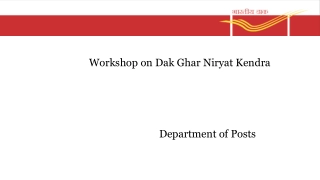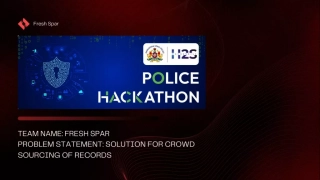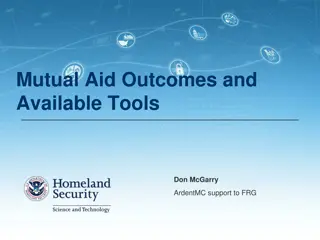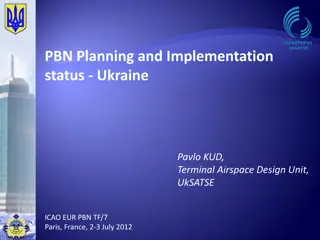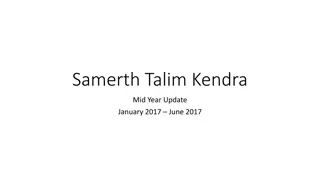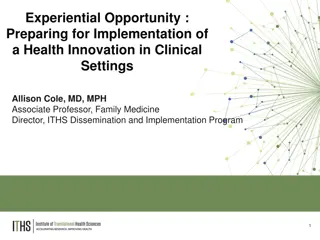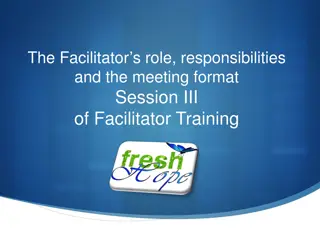A Fresh Look at Kendra's Law Implementation
This presentation explores the implementation of Kendra's Law from a fresh perspective, covering regional leadership, communication paths, SAFE Act updates, challenges, and clinical insights. It also introduces key staff members and contact information related to Assisted Outpatient Treatment (AOT).
Download Presentation

Please find below an Image/Link to download the presentation.
The content on the website is provided AS IS for your information and personal use only. It may not be sold, licensed, or shared on other websites without obtaining consent from the author.If you encounter any issues during the download, it is possible that the publisher has removed the file from their server.
You are allowed to download the files provided on this website for personal or commercial use, subject to the condition that they are used lawfully. All files are the property of their respective owners.
The content on the website is provided AS IS for your information and personal use only. It may not be sold, licensed, or shared on other websites without obtaining consent from the author.
E N D
Presentation Transcript
Kendras Law: A Fresh Look Rebecca Briney, LMSW Lisa Dixon, M.D., M.P.H.
Disclosures Presenter Name(s): Rebecca Briney, LMSW and Lisa Dixon, MD, MPH These planners and presenters do not have any financial arrangements or affiliations with any commercial entities whose product, research, or services may be discussed in these materials.
Objectives To specify the regional and statewide leadership and standard communication paths To highlight SAFE Act updates to AOT To highlight issues and challenges related to the AOT timeline To highlight some clinical perspectives on AOT orders and implementation
Objectives To specify the regional and statewide leadership and standard communication paths To highlight SAFE Act updates to AOT To highlight issues and challenges related to the AOT timeline To highlight some clinical perspectives on AOT orders and implementation
New OMH Staff Albany Rebecca Briney Statewide Director Rebecca.Briney@omh.ny.gov Nancy Pepe Counsel for AOT Nancy.Pepe@omh.ny.gov Tom Gottehrer Program Specialist Tom.Gottehrer@omh.ny.gov Natalie Bowen Administrative Support Natalie.Bowen@omh.ny.gov
Additional Contact Info OMH Central Office AOT team 518-402-4233 NYS OMH 44 Holland Ave. 7thFloor Albany, NY 12229
Statewide AOT Team AOT Regional Coordinators appointed by the Commissioner at each of OMH s five field offices. NYC Paul Iappini - 212-330-6376 Paul.Iappini@omh.ny Central NY Duane Hall 315-426-3948 Duane.Hall@omh.ny.gov
Statewide AOT Team Western NY Elizabeth Haley 716-533-4080 Elizabeth.Haley@omh.ny.gov Long Island Zinnat Rahman - 631-761-2092 Zinnat.Rahman@omh.ny.gov Hudson River Cherie Seidewand - 845-454-8229 Cherie.Seidewand@omh.ny.gov
Communication Flow Statewide OMH AOT Team: Monthly Video Teleconferences Quarterly in-person meetings in Albany In-Person Regional meetings hosted by OMH Regional Coordinators at least annually for county AOT Coordinators Communication flow in your county with key players?
Communication Flow Information Sharing Send court order information via fax to your counties AOT secure fax account Allows county AOT staff to securely send info via a fax, that will be received in email format at the field office receiving end. Makes paperless filing possible and decreases information security concerns.
Regional Secure AOT Fax Account Numbers Long Island 877-849-1068 NYC 877-468-1530 or 877-849-1063 Central 877-838-1829 Western 877-849-1064 Hudson 877-849-1067
Objectives To specify the regional and statewide leadership and standard communication paths To highlight SAFE Act updates to AOT To highlight issues and challenges related to the AOT timeline To highlight some clinical perspectives on AOT orders and implementation
SAFE Act Effective 3/16/13 Length of the order up to one year (9.60(j)(2)) Transfers across counties (9.48(2)(c)) Individuals returning to the community from CNYPC inpatient units
Safe Act Formalized DCS role in evaluating the need for AOT orders to be renewed (9.60(k)(1)) Petitions can be filed even when a client can t be located (9.60(k)(1)) Orders remain in effect while renewals are pending (9.60(k)(2))
Objectives To specify the regional and statewide leadership and standard communication paths To highlight SAFE Act updates to AOT To highlight issues and challenges related to the AOT timeline To highlight some clinical perspectives on AOT orders and implementation
AOT Time Lines Hearings need to be scheduled within 3 days of filing of petition or renewal (9.60(h)(1)) Repeated adjournments and delays compromise implementation of order (9.60(h)(1)) Serving signed final orders to the DCS enables them to meet their statutory responsibilities (9.60(j)(6) Routine court schedule and routine staff for AOT can help
Renewing an Order Examining physician makes a clinical determination regarding whether to renew the AOT order Renewal of order does NOT require that the individual meet either the 36 m or 48 m criteria regarding previous hospitalization or acts of violence
Renewing an Order Nota Bene: Timing is key. DCS must apply to renew order within 30 days of termination of order. If that does not happen, and the order is allowed to expire, the next order is no longer considered a renewal, but rather an initial petition, and the criteria regarding violence and hospitalization DO apply The order can continue to be renewed as long as the individual continues to meet all of the other criteria and it is clinically determined that (s)he is likely to benefit from the order
Renewing an Order Criteria for renewal of order does NOT require an episode of noncompliance or the initiation of a removal order Examining physician makes a clinical determination and considers level of risk associated with past behaviors (9.60(c)(3))
Renewing an Order In assessing likelihood of benefit, clinician must consider a range of issues including awareness and appreciation of illness, impact of order on behavior, and other supports The length of the order requested takes into account the treatment team s experience with that individual and the expectation of what will occur in the timeframe
AOT Is Not the Same As ACT AOT = Assisted Outpatient Treatment County operated referral and monitoring program that does not provide direct treatment ACT = Assertive Community Treatment An evidence based practice in which a community based treatment team that provides care management, psychiatry and clinical services Many, BUT NOT ALL, AOT clients receive ACT services Many, BUT NOT ALL, ACT clients are on AOT orders
The AOT Process: Challenges for Psychiatrists Providing Testimony Systemically, overall shortage of psychiatrists Time for court appearances very precious Problematic impact of inability to coordinate court schedule with physician s availability Nobody can stand in for psychiatrist Physicians will routinely obtain and utilize information in the clinical record
Clinical Perspectives: Consideration of Injectable Mediations Disorders experienced by people with AOT orders have a range of evidence-based medication treatments, e.g., psychosis, depression, mania Most people have difficulty with adherence Long acting medications (sometimes injectable) can help people remain adherent in a number of disorders Case examples
AOT Manual Online Resources OMH AOT portal has been updated https://my.omh.ny.gov/bi/aot State and County Contact info Safe Act updates including AOT forms Guidance tab added Transfers across counties AOT Care Management Health Home Plus Reporting Requirements
Conclusion/Summary Clinical challenges in implementation of AOT include optimally using the contributions of psychiatry and understanding clinical decision making around AOT renewal decisions






